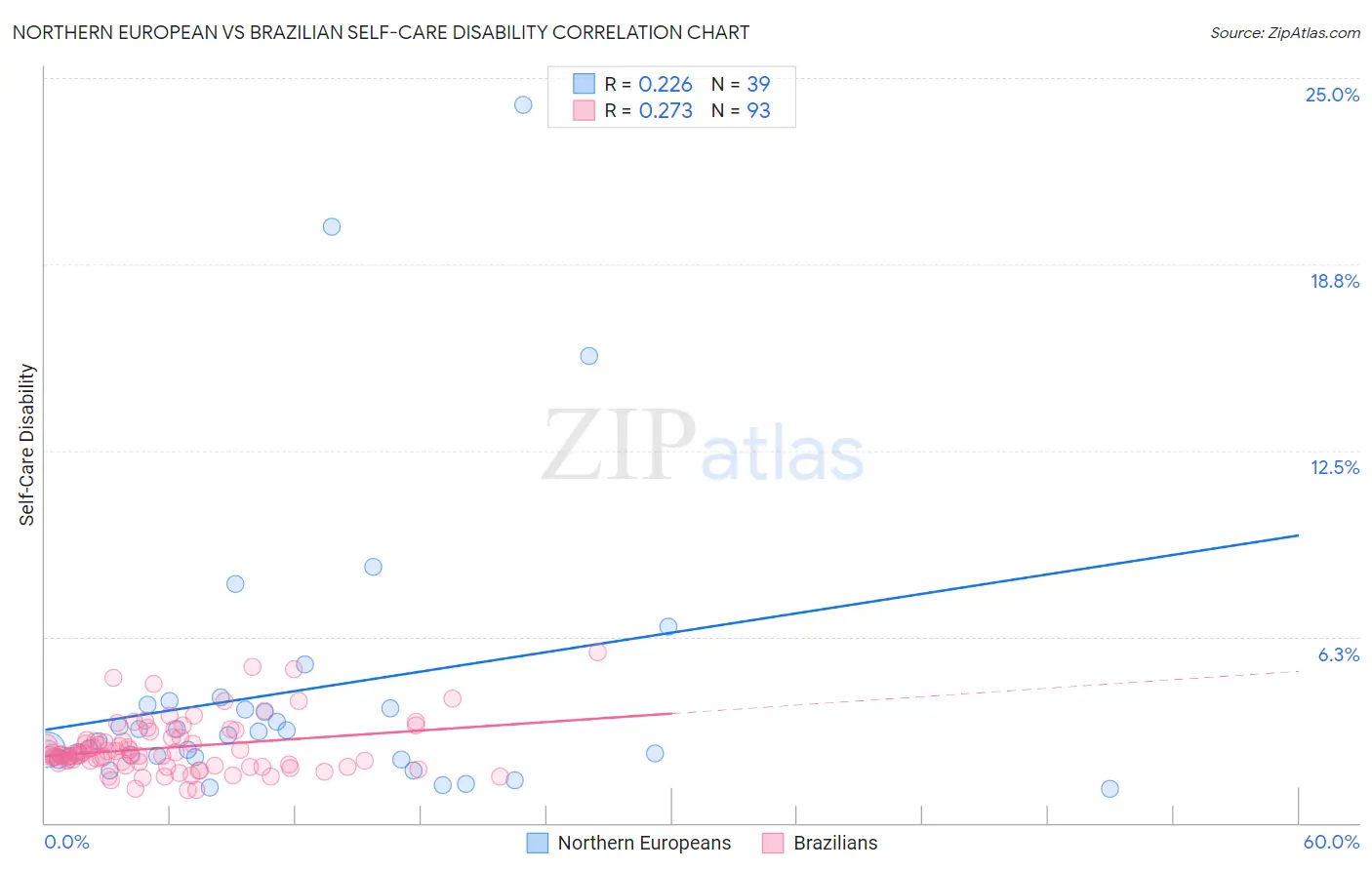Northern European vs Brazilian Self-Care Disability
COMPARE
Northern European
Brazilian
Self-Care Disability
Self-Care Disability Comparison
Northern Europeans
Brazilians
2.4%
SELF-CARE DISABILITY
92.9/ 100
METRIC RATING
116th/ 347
METRIC RANK
2.3%
SELF-CARE DISABILITY
99.3/ 100
METRIC RATING
65th/ 347
METRIC RANK
Northern European vs Brazilian Self-Care Disability Correlation Chart
The statistical analysis conducted on geographies consisting of 405,623,897 people shows a weak positive correlation between the proportion of Northern Europeans and percentage of population with self-care disability in the United States with a correlation coefficient (R) of 0.226 and weighted average of 2.4%. Similarly, the statistical analysis conducted on geographies consisting of 323,606,660 people shows a weak positive correlation between the proportion of Brazilians and percentage of population with self-care disability in the United States with a correlation coefficient (R) of 0.273 and weighted average of 2.3%, a difference of 3.0%.

Self-Care Disability Correlation Summary
| Measurement | Northern European | Brazilian |
| Minimum | 1.2% | 1.1% |
| Maximum | 24.1% | 5.7% |
| Range | 22.9% | 4.6% |
| Mean | 4.4% | 2.5% |
| Median | 3.0% | 2.3% |
| Interquartile 25% (IQ1) | 2.2% | 1.9% |
| Interquartile 75% (IQ3) | 4.0% | 2.9% |
| Interquartile Range (IQR) | 1.8% | 0.91% |
| Standard Deviation (Sample) | 4.9% | 0.90% |
| Standard Deviation (Population) | 4.9% | 0.90% |
Similar Demographics by Self-Care Disability
Demographics Similar to Northern Europeans by Self-Care Disability
In terms of self-care disability, the demographic groups most similar to Northern Europeans are Immigrants from North Macedonia (2.4%, a difference of 0.050%), Immigrants from Hong Kong (2.4%, a difference of 0.050%), South American (2.4%, a difference of 0.060%), Taiwanese (2.4%, a difference of 0.060%), and Scandinavian (2.4%, a difference of 0.12%).
| Demographics | Rating | Rank | Self-Care Disability |
| Slovenes | 94.1 /100 | #109 | Exceptional 2.4% |
| Immigrants | Africa | 93.7 /100 | #110 | Exceptional 2.4% |
| Serbians | 93.6 /100 | #111 | Exceptional 2.4% |
| Scandinavians | 93.5 /100 | #112 | Exceptional 2.4% |
| South Americans | 93.2 /100 | #113 | Exceptional 2.4% |
| Immigrants | North Macedonia | 93.1 /100 | #114 | Exceptional 2.4% |
| Immigrants | Hong Kong | 93.1 /100 | #115 | Exceptional 2.4% |
| Northern Europeans | 92.9 /100 | #116 | Exceptional 2.4% |
| Taiwanese | 92.5 /100 | #117 | Exceptional 2.4% |
| Immigrants | Canada | 92.0 /100 | #118 | Exceptional 2.4% |
| Immigrants | Sierra Leone | 91.8 /100 | #119 | Exceptional 2.4% |
| Uruguayans | 91.5 /100 | #120 | Exceptional 2.4% |
| Peruvians | 91.3 /100 | #121 | Exceptional 2.4% |
| Belgians | 90.9 /100 | #122 | Exceptional 2.4% |
| Immigrants | Nigeria | 90.3 /100 | #123 | Exceptional 2.4% |
Demographics Similar to Brazilians by Self-Care Disability
In terms of self-care disability, the demographic groups most similar to Brazilians are Immigrants from Argentina (2.3%, a difference of 0.030%), Swedish (2.3%, a difference of 0.060%), South African (2.3%, a difference of 0.060%), Mongolian (2.3%, a difference of 0.070%), and Immigrants from Zaire (2.3%, a difference of 0.15%).
| Demographics | Rating | Rank | Self-Care Disability |
| Immigrants | Cameroon | 99.6 /100 | #58 | Exceptional 2.3% |
| New Zealanders | 99.5 /100 | #59 | Exceptional 2.3% |
| Immigrants | Japan | 99.5 /100 | #60 | Exceptional 2.3% |
| Palestinians | 99.4 /100 | #61 | Exceptional 2.3% |
| Egyptians | 99.4 /100 | #62 | Exceptional 2.3% |
| Mongolians | 99.3 /100 | #63 | Exceptional 2.3% |
| Swedes | 99.3 /100 | #64 | Exceptional 2.3% |
| Brazilians | 99.3 /100 | #65 | Exceptional 2.3% |
| Immigrants | Argentina | 99.3 /100 | #66 | Exceptional 2.3% |
| South Africans | 99.3 /100 | #67 | Exceptional 2.3% |
| Immigrants | Zaire | 99.2 /100 | #68 | Exceptional 2.3% |
| Immigrants | Norway | 99.2 /100 | #69 | Exceptional 2.3% |
| Immigrants | Northern Europe | 99.2 /100 | #70 | Exceptional 2.3% |
| Asians | 99.2 /100 | #71 | Exceptional 2.3% |
| Eastern Europeans | 99.2 /100 | #72 | Exceptional 2.3% |